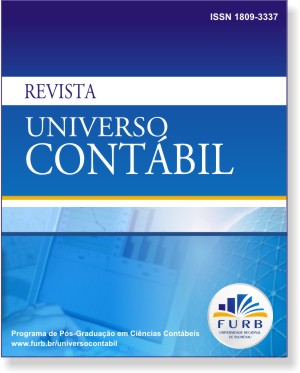HIGH SCHOOL STUDENTS' PERCEPTIONS OF AN ACCOUNTANT'S RESPONSIBILITIES
Keywords:
High School Students, Abilities, Accountant's Area of PerformanceAbstract
The choice of a profession is undoubtedly one of the most important decisions in a person's life. Having adequate information, free of stereotypes and biases is also important, both for the professional future, and for society in general that will utilize the services the professional will render. Thus, the objective of this study was to identify the skills and knowledge that high school students deem necessary for the accountant, as well as compare if such skills and knowledge are converging to those recommended by the IFAC (International Federation of Accountants), which aims to improve the profession and the accounting professionals. The survey was conducted with high school students in the year 2013. The population comprised of 12 public schools, located in the city of Uberlândia-MG, with 841 respondents. The results showed that the perception of high school students converges to many skills described by the IFAC, with greater agreement for technical and functional skills. The findings of this study indicate that students do not know the extent of the area of expertise of professionals in accounting, which may affect their choice of the profession. It is concluded that there is a stereotype in relation to the Accounting Professional, considering that the students understand that the accountant works mainly with contents of the area of exact sciences, which can intimidate those who do not like such area. Thus, the study contributes by promoting reflection and dissemination of the skills and knowledge provided by accounting education related bodies, involving the perception of high school students, future professionals, as to the performance of the Accounting Professional.
Downloads
References
BRASIL. Resolução CNE/ CES nº. 10, de 16 de dezembro de 2004. Institui as Diretrizes Nacionais Curriculares para o Curso de Graduação em Ciências Contábeis, bacharelado, e dá outras providências. In: CONSELHO NACIONAL DE EDUCAÇÃO – CÂMARA DE EDUDAÇÃO SUPERIOR. Legislação Republicana Brasileira. Brasília, 2004. Disponível em: <http://portal.mec.gov.br/cne/arquivos/pdf/rces10_04.pdf>. Acesso em: 26 nov. 2013.
CARDOSO, J. L.; SOUZA, M. A.; ALMEIDA, L. B. de. Perfil do Contador na atualidade: um estudo exploratório. BASE - Revista de Administração e Contabilidade da Unisinos, v. 3 n. 3, p. 275-284, set/dez. 2006.
CONSELHO FEDERAL DE CONTABILIDADE (CFC). Pesquisa perfil do profissional da contabilidade 2012/13 / Conselho Federal de Contabilidade. Brasília: CFC, 2013. Disponível em: http://portalcfc.org.br/wordpress/wp-content/uploads/2013/12/livro_perfil_2013_web2.pdf. Acesso em: 14 fev. 2014.
______. Resolução CFC nº 560/83, de 28 de outubro de 1983. Dispõe sobre as prerrogativas profissionais de que trata o artigo 25 do Decreto-lei nº 9.295, de 27 de maio de 1946. Disponível em: Acesso em: 14 fev. 2014.
EVANGELISTA, A.A. O currículo dos cursos de Ciências Contábeis e o mercado de trabalho para o profissional contador. 2005.147p. Dissertação (Mestrado) - Centro Universitário Álvares Penteado, São Paulo,2005.
GIL, A. C. Como elaborar projetos de pesquisa. 4. ed. São Paulo: Atlas, 2006.
INTERNATIONAL FEDERATION OF ACCOUNTANTS (IFAC). Proposed International Education Standard (IES) 3, 2012. New York. Disponível em: <http://www.ifac.org/sites/default/files/publications/files/IES%203%20Exposure%20Draft%20and%20Memo_VDRAFT2-formatted%20(3)_0.pdf>. Acesso em: 27 nov. 2013.
MARTINS, N. T. F.; LEAL, E. A. Habilidades e Competências Requeridas do Contador: um estudo com os egressos do Curso de Ciências Contábeis. In: Congresso Nacional de Administração e Ciências Contábeis–AdCont, 3., 2012. Rio de Janeiro. Anais... Rio de Janeiro, out. 2012.
LEAL, E. A.; SOARES, M. A.; SOUSA, E. G. Perspectivas dos formandos do curso de Ciências Contábeis e as exigências do mercado de trabalho. Revista Contemporânea de Contabilidade, v. 1, n. 10, p. 147-159, jul/dez., 2008.
LEMES, D. F. ; MIRANDA, G. J. Habilidades Profissionais do Contador Preconizadas pela IFAC: um estudo com profissionais da região do Triângulo Mineiro. Advances in Scientific and Applied Accounting, v.7, n.2, p. 293-316, 2014. DOI: http://dx.doi.org/10.14392/asaa.2014070206
MARIN, T. I. S.; LIMA, S. J.; CASA NOVA, S. P. C. Formação do contador o que o mercado quer, é o que ele tem? In: Congresso USP de Controladoria e Contabilidade, 11., 2011, São Paulo. Anais ... São Paulo: FIPECAFI, 2011.
MARION, J. C. Análise das demonstrações contábeis. 4.ed. São Paulo: Atlas, 2009.
MIRANDA, G.J; LEAL, E. A; MEDEIROS, C. R. O; LEMES, S. Representações sociais de vestibulandos: (RE) Construindo o Estereótipo dos profissionais da Contabilidade. In: Congresso ANPCONT, 7., 2013, Fortaleza. Anais... Fortaleza, jun. 2013.
OTT, E; CUNHA, J V. A; CORNACHIONE JUNIOR, E. B; MENDES DE LUCA, M. M. Relevância dos conhecimentos, habilidades e métodos instrucionais na perspectiva de estudantes e profissionais da Área contábil: estudo comparativo internacional. Revista Contabilidade e Finanças, São Paulo, v. 22, n. 57, p. 338-356, 2011. DOI: http://dx.doi.org/10.1590/S1519-70772011000300007
PIRES, C. B.; OTT, E; DAMACENA, C. A formação e a demanda do mercado de trabalho do contador na região metropolitana de Porto Alegre-RS. BASE- Revista de Administração e Contabilidade da Unisinos, v. 7, n.4, p. 315-327, out./dez. 2010.
SCARPIN, M. A.; ALMEIDA, W. C. Graduandos de Ciências Contábeis e sua carreira profissional. Revista de Estudos Contábeis, v. 1, n. 1, p. 24-37, 2010.
TAMER, C. M. V. S.; VIANA, C. C.; SOARES, L. A. C. F.; LIMA, M. S. Perfil do Profissional Contábil demandado pelo mercado de trabalho: um estudo no norte do Brasil. Revista Universo Contábil, v. 9. n.3, p.143-162 jul./set. 2013. DOI:10.4270/ruc.2013326
Published
How to Cite
Issue
Section
License
The copyright for papers published in this journal belong to the author, with rights of first publication for the journal. As the papers appears in this publicly accessed journal, the papers are for free use, receiving their credit, in educational and non-commercial uses. The journal will allow the use of the papers published for non-commercial purposes, including the right to send the paper to publicly accessed databases.


